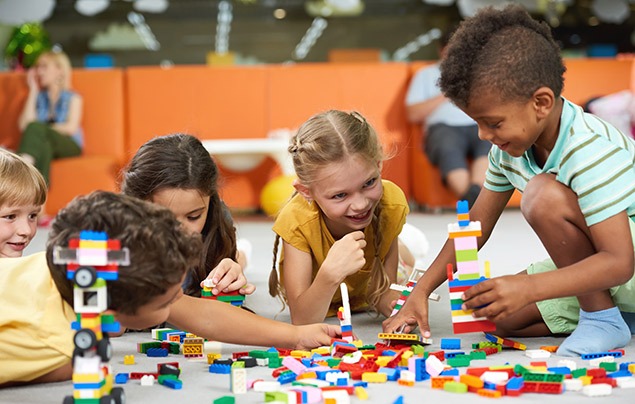Creative kids: how to inspire their growing minds
Help your little learners get creative and develop problem-solving skills!
Research shows that children are naturally creative from a young age – and scientists agree that kids who remain creative prove to be better problem-solvers and innovators. These creative kids also tend to be less anxious and more resilient, with a greater ability to express their feelings.
“The more a child believes in their powers of creativity, the more they believe that whatever happens to them, they can overcome it because they can figure out a way to survive,” says Angus Fletcher, professor of story science at Ohio State University’s Project Narrative.
But the creativity that young children exhibit doesn’t necessarily last. A well-known study of 1,600 four- and five-year-olds found that 98% of the children scored in the “creative genius” range on a NASA creativity test. But after five years, 30% of those kids maintained the score – and five years later, only 12% hit creative genius levels.
One reason is neurological. Researchers from the University of California found that by age three, a child’s brain is twice as active as an adult’s. But as the children get older, some neural connections are strengthened while others are pruned, transforming the brain from flexible and sensitive to more effective and controlled.
Another major factor is how children learn in structured school environments. “Standardised testing, for example, encourages kids to think that there are right answers and wrong ones.” Fletcher says. “That way of thinking negatively impacts creativity, because creativity depends on the brain thinking that there are multiple possible answers.”
Supporting your creative kids
Fortunately, those creative attributes that many young children display don’t have to disappear as they grow older. The UC Berkeley researchers theorised that a playful protected environment could lead to more flexible, exploratory, and childlike learning—even in adulthood. “Creativity is a skill that can be developed and strengthened over time,” Fletcher says.
It can be difficult to know where to start, so don’t be afraid to use things your kid already loves to help inspire joyful, imaginative play.
Perhaps you could look through books they love, and imagine yourselves in the worlds of their favourite characters. Or you might nurture their creativity with a subscription to National Geographic Kids magazine. Each issue is packed with brain-boosting puzzles, games and things to do, and with pages full of wonders from around the natural world, it will help inspire their imagination too!
For the rest of this article, we’ve tapped into four creative skills that almost all kids exhibit. Here’s how to help them continue to exercise those creative muscles throughout their lives…
Creative skill #1: Playing — all the time.
From stacking blocks to kneading clay to climbing trees, creative kids can be engrossed in imaginative play for hours, with friends or by themselves. “Creativity is something innate in humans, and it’s fostered naturally through play,” says Nancy Carlsson-Paige, author of Taking Back Childhood: A Proven Roadmap for Raising Confident, Creative, Compassionate Kids.
Play is often just for fun, but it can also help resolve upset feelings, conflict or trauma. “It’s giving them an opportunity to re-enact things they’ve experienced that they still need to work through,” she says.
How to encourage more creative play
Unlike board games or sports with rules and goals, free play is meant to be unstructured with no real purpose. Carlsson-Paige encourages parents to allow children to play on their own, even if it seems unproductive. If they want you to join them, let them take the lead.
She also recommends setting up a dedicated play area, even if it’s just a corner in a room. Stock the space with open-ended materials, such as hats, scarves, and costume jewellery from the thrift store; recycled materials like refrigerator boxes and old newspapers and building materials, art supplies, or sets of wooden blocks.
“Any of these open-ended materials will allow for children to make up their own stories and decide from their own creative impulse and needs,” Carlsson-Paige says.
Creative skill #2: Imagining all the things.
Children are uninhibited and have a talent for dreaming up stories in the world of make-believe, excitedly regaling tales of powerful wizards and dancing bears. That can serve them well as adults – after all, who imagined 30 years ago that a tiny, magical device would make phone calls, send messages, stream shows and take photos?
How to inspire imagination in creative kids
Teach children to think of all scenarios, even the far-fetched ones. “Rather than being fact givers and repeating information, parents should provide children with the skills to be problem-solvers and risk takers,” says Rebecca Isbell, author of Nurturing Creativity: An Essential Mindset for Young Children’s Learning.
Start by asking kids open-ended questions. For example, “What if the rain came from the ground to the clouds, instead of the clouds to the ground? How would the world be different?” The child will then have to come up with an alternative to an umbrella or suggest different ideas to capture rain. Or, when you’re out on an errand to the grocery store, ask your child, “If you could invent a brand-new food, what would it be? What would that taste like?” These can be great for breaking up the boredom on a long drive, too!
For a hands-on activity, suggest that instead of buying a birthday present for a family member, the child can create a time machine using only things they can find in the garden. Or maybe come up with a new outfit from materials they can find in a kitchen.
Creative skill #3: Seeing things differently—really differently.
Ask a child how many ways they could use a cup, and their answers might surprise you: a hat, a hammer, a scoop, a shovel, a drum, etc. “One of the key components of creativity is looking at things from a new perspective and connecting disparate things that might not otherwise connect to come up with a unique or original idea or invention,” says Catherine Thimmesh, author of Girls Solve Everything.
How to encourage kids to develop new perspectives
Challenge your child to look at things from a different angle or viewpoint. For example, if your child normally walks from the living room into the kitchen, ask them up come up with a new pathway. Add in fun obstacles like, “without your feet touching the ground.”
“Have them think and problem-solve,” Thimmesh says. “Maybe they can get their sibling to roll them into the kitchen, or maybe they’ll put pillows on the floor like stepping-stones.”
Or, if a child likes to picture themselves as a superhero, you can help build their skills by asking them to imagine themselves as the nemesis. What’s different about that person’s mind or how they think? How would this character defeat the hero?
Creative skill #4: Super-strong curiosity.
“Young children have not been inhibited by the world yet,” Isbell says. “They’re very curious about everything, and they want to know how things work and fit together.” The problem, she adds, is when society’s rules make children afraid of failure and get in the way of that curiosity.
How to inspire curiosity in creative kids
Show interest in your child’s idea or exploration efforts. “It can help build their creative confidence as they learn that their thinking is valued and encouraged,” Isbell says.
Encourage your kids to channel their inner explorer and think creatively while they’re outside. For example, if your child is looking at a stone on the ground at the zoo instead of the elephants, allow the child to investigate the thing that piqued their interest – and ask them about it, too.
Another way a parent can help is to model how to deal with mistakes. Making mistakes is part of the creative process, and the fear of failure can impede curiosity and innovation. So, ask your child to “teach” you a game or about a project they’re working on. “Then the parent should deliberately make a mistake and patiently let the child try to help them,” says Thimmesh.
Two things happen. The child becomes the expert and feels empowered. Plus, they see that the grownup, who’s supposed to know everything, is still trying and asking questions.
Or you can try the improvisational comedy technique “Yes, and …” in which a stated answer is accepted (“yes”) and the line of thinking can be extended (“and”). Fletcher says this encourages children to gently expand their conclusion or identify a hidden success in what seems like a failure. By not passing judgments on their answers, you’ll create confidence in your child and encourage them to stay curious.

















LEAVE A COMMENT
THANK YOU
Your comment will be checked and approved shortly.
WELL DONE,
YOUR COMMENT
HAS BEEN ADDED!
COMMENTS
CUSTOMIZE YOUR AVATAR